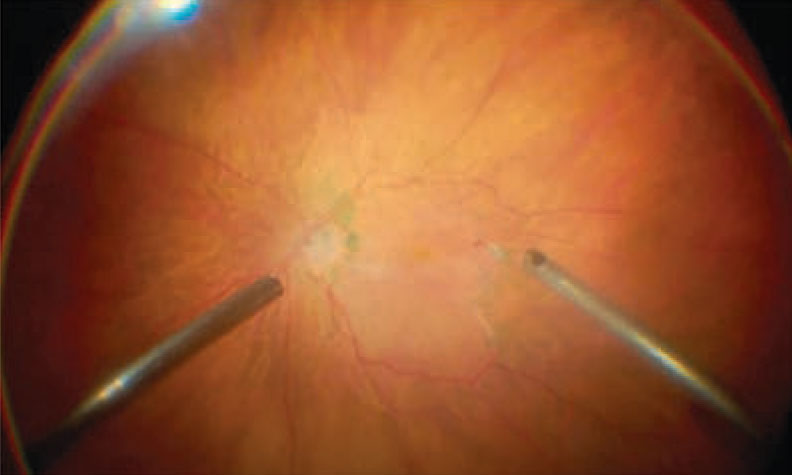 |
| Due to the exceedingly high GWP100 of fluorinated gases and the gas waste linked to some of the delivery systems used in vitreoretinal surgery, carbon emissions were much more significant than anticipated. Photo: Derek N. Cunningham, OD, and Walter O. Whitley, OD. Click image to enlarge. |
Gas tamponade for retinal surgery isn’t usually the first thing that comes to mind when we think of greenhouse gas emissions, but a new study says that maybe it should. The study assessed the carbon footprint of different gas delivery methods in several UK hospital centers and found that there’s significant waste associated with large gas cylinders.
Healthcare is estimated to contribute about four to five percent of all global greenhouse emissions. In the UK alone, the NHS, which is the largest funded healthcare system in the world, produced a carbon footprint of 25 megatons of carbon dioxide equivalent. That’s the equivalent to 11 coal power stations and represents 5.4% of the UK’s total greenhouse gas emissions. In October 2020, the NHS became the first healthcare system to commit to a carbon net zero target by 2040.
The gases in question are fluorinated gases—sulphur hexafluoride (SF6), hexafluoroethane (C2F6) and octafluoropropane (C3F8)—commonly used in vitreoretinal surgery. They’re also among the most potent of the greenhouse gases. SF6 in particular was identified by the Kyoto Protocol as one of six gases that would require strict regulation and limited use due to its impact on global warming. Fortunately, the literature suggests that reducing these emissions could result in health benefits, cost reductions in healthcare delivery and increased patient satisfaction.
The researchers analyzed all vitreoretinal procedures that used fluorinated gases between 2017 and 2020 at the Manchester Royal Eye Hospital (MREH) and Birmingham and Midland Eye Centre (BMEC)—the second and third largest vitreoretinal centers in the UK. They also included the University Hospitals of Coventry and Warwickshire (UHCW) between 2019 and 2020. The carbon dioxide equivalent mass (CO2EM) was calculated from the mass of each gas used, based on the Intergovernmental Panel on Climate Change.
There were a total of 4,877 procedures (1,883 SF6 [38.6%]; 2,096 C2F6 [43%]; 897 C3F8 [18.4%]). UHCW and BMEC used single-use 30ml and 75ml canisters, respectively. MREH used four cylinders of each gas over a four-year period (2kg of SF6, 1kg C2F6, 1kg C3F8).
The researchers say the average CO2EM per patient was 111.8kg at MREH, 7.5kg at BMEC and 2.7kg at UHCW. “For MREH and BMEC, the CO2EM was 73.4 metric tons annually, (if all cases performed with a) 30ml: 3.7 tons and b) cylinders: 148.0 tons, x40 fold difference); equating to 599.4 thousand (30.5 thousand to 1.2 million) km travelled by a passenger car,” they explained. “Current use of SF6 in VR surgery accounts for 0.11% of total SF6 use,” they added. “If 30ml cylinders were exclusively used in the UK, this could be lowered to 0.01%.”
Vitreoretinal gas usage hasn’t received much attention and has long been considered a negligible contributor to carbon emissions, the researchers pointed out in their paper. “This isn’t surprising considering the small intraocular volume used, relative to other aspects of healthcare provision and to other industries. However, due to the exceedingly high GWP100 of fluorinated gases and the gas waste linked to some of the delivery systems used in vitreoretinal surgery, we found that the carbon emissions can be much more significant than anticipated. We also discovered that this problem can be considerably alleviated [by] employing single-use [30ml] gas canisters, which offer a predictable and relatively low carbon dioxide equivalent mass.”
Theoretically, a single gas cylinder would be sufficient to perform all vitreoretinal operations at all three of these ophthalmology centers over four years, but gas cylinders expire after three years, which leads to significant waste. “Just one 2kg cylinder of SF6 is theoretically sufficient to provide enough gas for >12,000 procedures within a three-year expiry period based on an average 25ml of SF6 extracted per operation. MREH performed the most SF6 operations in our cohort over four years, with 1,206 operations. This represents a significant underutilization of the capacity of a single cylinder (approximately 10%). In addition, large units where vitreoretinal operations are performed in different ophthalmic theaters simultaneously, multiple cylinders are required to guarantee patient flow, which further adds to the carbon emissions.”
Moussa G, Ch’ng S, Park D, et al. Environmental effect of fluorinated gases in vitreoretinal surgery: a multicenter study of 4,877 patients. Am J Ophthalmol. September 26, 2021. [Epub ahead of print]. |

